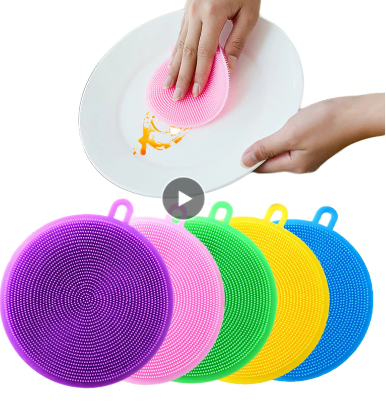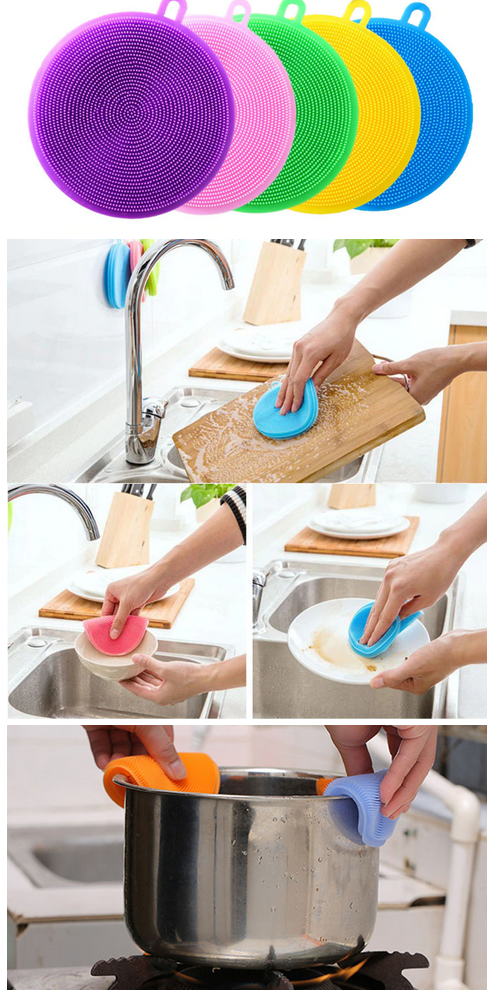nozzle wipe
-
I'm using this ATTM for nozzle wipe on my Ender5 machine
https://www.myminifactory.com/object/3d-print-nozzle-wipe-for-ender-5-118314The "silicone" stripe that is supposed to be used is now some piece of original magnetic print surface Ender5 came with. It was "bendable" and I assume will work, at least for a while. It worked for less then a week then started to "crumble" and "rot" so I need a real silicone. I have somewhere a 1mm thick sheet of silicone but can't find it in the mess I made out of my workshop so started looking around for alternative solutions and found this:
https://www.aliexpress.com/item/33030117840.html
It costs less then a buck and is temp resistent. I tried 320C with my soldering iron as that's the max temp I will use it with and the soldering iron could not touch it :D, it actually cleaned my soldering iron nicely from the previous test of some kids "rubber lego" that left some gunk on the iron.
Looks like ideal surface tu burry your hotend into and wipe it

I have not tried it yet (I did clean nozzle with it by hand), will report back when I mount it somehow and try it in real life

I know aliexpress links don't last long so:
Silicone Cleaning Brush Dishwashing Sponge Multi-functional Fruit Vegetable Cutlery Kitchenware Brushes Kitchen Tools


-
The examples of nozzle wipes I saw were metal brushes, more like this https://www.aliexpress.com/item/32918753824.html
-
I attempted to clean the nozzle using a wire brush and didn't have much success. I didn't mess with it much after the initial attempt, so maybe it can be made to work. I was thinking maybe a combo of wire brush and silicone or teflon blade
-
Wire brushes wear down the nozzle and the bristles bend and become less effective. I like your idea on using the dish cscribber though, just concerned it would take a good amount of space.
Working on a design that uses the silicone blade from a squeege (used to wipe water off windows). Got this idea from @deckingman.
Properly supported it should clean the nozzle well, filament debris should not build up and stick to the blade (filament doesn’t stick well to silicone), it should not wear the nozzle, takes little space and it should retain shape.
Added to the print start gcode will be a macro that zig zags across it a few times.
-
Somehow I don't think a wire brush is a good idea unless you have a hardened nozzle. I suspect the brass used in brass brushes is also of a harder alloy then a standard brass nozzle and I would think that you would see some wear depending on how often you wipe.
The thing that would concern me most is the wires of the brush interacting with the inside edge of the nozzle. I can see that edge getting rounded and then affecting the clean and precise flow of the extruded plastic.
I could see a combination of two cleaning surfaces - occasional brass brush but normal cleaning done by silicone -
Here is an example of a professional one
Edit: and here is a video by DPT
https://www.youtube.com/watch?v=PhiDD0E_Fjg -
@zapta said in nozzle wipe:
The examples of nozzle wipes I saw were metal brushes, more like this https://www.aliexpress.com/item/32918753824.html
I'm using brass brash when cleaning by hand. Issue I have with brass brush is with these new X nozzles from E3D that come with some plastic-fobic coating .. no clue how hard that thing is and if wires will scrub it
 .. also, brushes shed and those bristles are nasty buggers when they enter cloathing, or skin, or god-forbid your electronics so I never use metal brushes for "automatic" cleanup.
.. also, brushes shed and those bristles are nasty buggers when they enter cloathing, or skin, or god-forbid your electronics so I never use metal brushes for "automatic" cleanup.What automatic cleaning needs to deal with is some oozing and that's about it, the silicone should be more than adequate. Normally one would use few mm thick strip of silicone and just go over it few times, problem is I don't have a stripe of silicone (if you look at my wiper, it's designed to hold a stripe of silicone
 ) so I'm trying this kitchen appliance
) so I'm trying this kitchen appliance 
-
@mrehorstdmd said in nozzle wipe:
I attempted to clean the nozzle using a wire brush and didn't have much success. I didn't mess with it much after the initial attempt, so maybe it can be made to work. I was thinking maybe a combo of wire brush and silicone or teflon blade
I clean them regularly with brass brush by hand.
I would skip on the teflon (PTFE) blade as it's normally "too stiff" and does not work good over 230C (release neurotoxin fumes) and I want solution up to 320C so...
-
@mwolter said in nozzle wipe:
just concerned it would take a good amount of space.
I just cut it and am preparing to do tests in an hour or so (if work stuff don't get in the way) so I'll share my experience. It could be a total failure, I'm prepared for that

Working on a design that uses the silicone blade from a squeege (used to wipe water off windows). Got this idea from @deckingman.
Yes, I seen his silicone strip and it inspired me to make this wiper in the first place! This is not nearly stiff as his rig but worked for a while with the magnetic rubber instead of silicone blade. Still don't have silicone blade so testing this "sponge" :). Getting stuff during quaranteene is hard, especially as we have these 2-3-4 day lasting "police hours" where you can't even go out to take the garbage
 so I have to do with what I can find in drawers, kitchen, kids toys...
so I have to do with what I can find in drawers, kitchen, kids toys... -
@zapta said in nozzle wipe:
Edit: and here is a video by DPT
https://www.youtube.com/watch?v=PhiDD0E_Fjghe's using the same PRC made brass brush I use for cleaning stuff. It comes in a package of 4, 2 different stifness plastic ones, one brass and one steel brush. These brass brushes leave scratch marks on the brass nozzle and aluminium heater block so are not very soft. They do clean the nozzle awesomly
 but I would not use them on the tip, and especially not for every print.
but I would not use them on the tip, and especially not for every print. -
Saw my name mentioned a few times in this thread. For info, I tried a few other things before ending up with the final design which uses a slot milled into a piece of aluminium to hold and support the silicone strip. Things that don't work are simply fixing it at both ends. No matter how much tension is applied, nor how close you can get the strip to the nozzle, it simply pushes the silicone out of the way rather than passing over it. For additional information, I'm still using the original strip and haven't yet needed to replace it. But when used with a purge, my "bucket" is too shallow so occasionally, the nozzle will pick up some previously purged filament at the end of the wipe and drag this back over the silicone strip. I need to fix that.....
-
@deckingman said in nozzle wipe:
Things that don't work are simply fixing it at both ends.
Assumed so, that's why I designed that wiper to hold the silicone strip from both sides throughout the full length. Unfortunately do not have the silicone strip so could not test it out

The milled channel you use, do you think without milling the channel and just using 2 L shape alu profiles 5x5mm screwed in the bed and silicone strip between them would work?
using the original strip
Where did you get the strip from if I may ask?
-
@arhi Anything that can clamp the silicone along one edge should work. You might be able glue it to a piece of something rigid. Not sure what would work - silicone adhesive maybe?
I honestly can't remember where I bought it from but it would likely be off eBay. I had to buy a 3 or 5 metre length but it wasn't expensive. -
@deckingman cool, when this whole thing finish I'll try to get one strip
 that looks perfect
that looks perfect 
-
def. has potential but not ideal .. this .6 nozzle is rather leeky need to add some retraction to wipe procedure
-
@arhi That video is private so I can't view it. For info, and in case you haven't seen it, you can see mine here from about 1min 40 secs https://www.youtube.com/watch?v=IG3AGKDzdH4
-
@deckingman thanks, I clicked on public and did not click on done but save and ... well happens
 should be public now
should be public now 
Yes, I have seen that video, and that's what inspired me to do this wiper in the first place as cleaning nozzle manually before homing is not very efficient due to the position of the printer and since I installed .6 nozzle there if I don't clean it before homing it will have nasty Z offset

I normally have some type of nozzle cleaner on every printer but I can't say I'm satisfied with any of them :(. This type is not possible on them as, usually, head can't move outside of the printbed area so anything mounted outside of the bed won't work. Here I have few cm so I used them
 ... now just to make it work.
... now just to make it work.IMO this will work for now but as soon as I can I'll add a second 2020 along side Y axis to hold on to the proper silicone strip.
As for the glue, dunno, I think I'll go with mechanical option, silicone, ptfe, pp, hdpe are materials I never had luck gluing.
-
@arhi Ref the YouTube videos - I discovered just the other day that you can also use "unlisted rather than "public". That way, they don't show up in your channel or any searches, but anyone with the link can view. Ref the "mechanical" option - if you had wide enough silicone, you could perhaps screw it to something flat, rather than sandwich it between two plates - might need some big washers. Just a thought........
-
If you have a U channel, why not use a couple of push pins in previously drilled holes near the top of the U channel as a mechanical fix to prevent the strip from being pushed out?
-
@jens55 said in nozzle wipe:
If you have a U channel, why not use a couple of push pins in previously drilled holes near the top of the U channel as a mechanical fix to prevent the strip from being pushed out?
That should work. Although in my case, I milled a slot the right size so that the silicone stays put without the need
